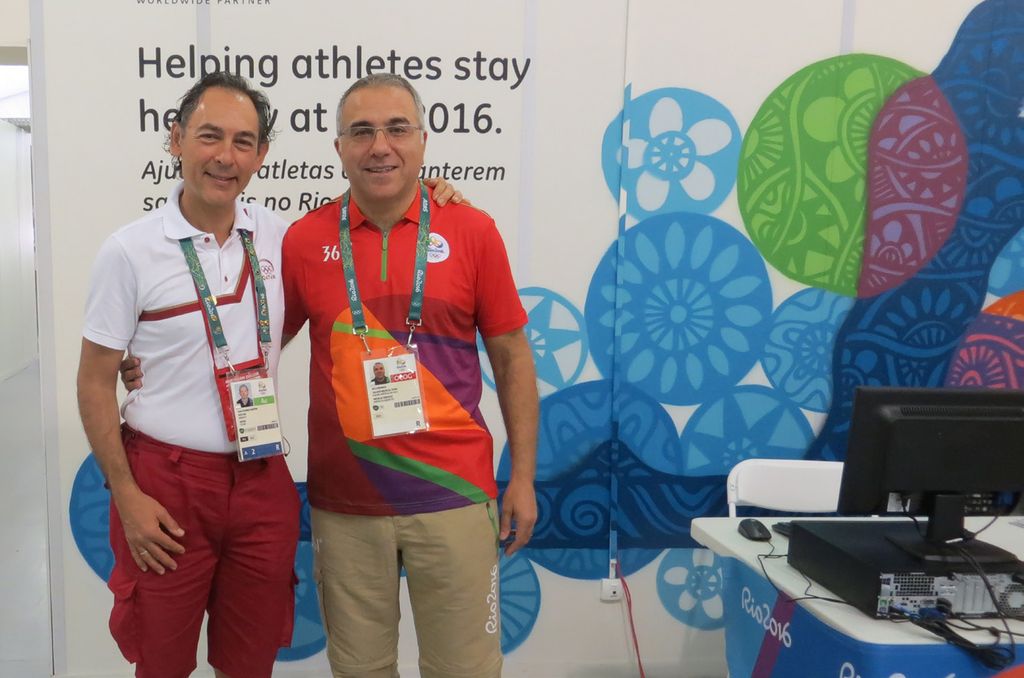Ali Guermazi Codirector of Radiology Research at Paris Olympics
As a basketball and tennis player of admittedly limited skills, Ali Guermazi, MD, PhD, MSc, would never be headed to the Olympics as an athlete. But as a radiologist and professor of radiology and medicine, Guermazi journeyed to his second Olympic games in eight years this summer when the Paris 2024 Organizing Committee for the Olympic and Paralympic Games named him codirector of radiology research for the Summer Games.
In the Olympic village from July 23 to August 12, Guermazi joined 32 radiologists and 36 radiographers, including Michel Crema, MD, an adjunct assistant professor of radiology at the school. For five of those days, he worked as a clinician, reading X-ray, ultrasound, and magnetic resonance imaging for athletes injured during the games. For the rest of the Olympics, he directed the collection of injury data with the goal of producing 20 research papers that the Olympic committee hopes will provide insight into training, injury prevention, and treatment.
“It’s all about best practice,” says Guermazi of the research. “The goal is to give [athletes, trainers, and coaches] an idea of why it happened and how to prevent it the next time.”
One of the papers from the 2016 Rio Olympics detailed the damage to muscles, connective tissue, and bone wrought by competition at the highest level, with more than 1,100 injuries diagnosed for 11,274 athletes. BMX cycling, with 38 percent of the athletes injured, and boxing, with 30 percent, topped the list.
“Thirty percent of the athletes who participated in the Rio de Janeiro Olympics had arthritis and were very young. Those were probably posttraumatic [injuries],” says Guermazi.
As chief of radiology at the VA Boston Healthcare System, he sees some similarities between military veterans and athletes.
“Almost every veteran has posttraumatic osteoarthritis because they went to war…and they do things that are very stressful on the joints,” he said. “We’re looking for treatment because at this point, there is no treatment.”
When injuries occur, the impact of a correct diagnosis and treatment of an injury play out in real time in the medical clinic. Not just muscles and bones are torn and shattered, but Olympic dreams as well. Whether the athlete enters the clinic accompanied by a coach or trainer, or with an entourage of a dozen people, as happens with the Olympic stars, the images reveal the toll of the pursuit of excellence.
“We can say to the athletes how long it’s probably going to be for them to return; if it’s five or six days and you can continue [competition], or if their Olympics are over,” says Guermazi, who has worked in sports medicine for 30 years. The 2015 book he coedited and helped author, Imaging in Sports-Specific Musculoskeletal Injuries, factored into his invitation to the 2016 Olympic Games in Rio de Janeiro.
These high-performing athletes are not typical people, Guermazi says, and their injuries are often way beyond what he sees in his sports medicine practice. But when they finally get to the Olympics after years of training, their drive to win is often stronger than their fear of injury.
 Ali Guermazi (right), a radiologist and professor of radiology and medicine, was part of a team of radiologists treating injured athletes at the 2024 Paris Summer Olympics. He previously served at the 2016 Rio de Janeiro Summer Games. Pictured with Juan Manuel Alonso, chief medical officer for the Rio de Janeiro 2016 Summer Olympic Games.
Ali Guermazi (right), a radiologist and professor of radiology and medicine, was part of a team of radiologists treating injured athletes at the 2024 Paris Summer Olympics. He previously served at the 2016 Rio de Janeiro Summer Games. Pictured with Juan Manuel Alonso, chief medical officer for the Rio de Janeiro 2016 Summer Olympic Games.
“They want to win. For them, it has to be first, not second or third,” he says. “When they get injured, it’s really big. You see the images and sometimes you say, ‘Oh my God, what’s this?’ It’s kind of mind-blowing.”
Guermazi is impressed by the athletes’ resilience and their capacity to endure pain and even risk long-term disability to succeed. He cites a champion judo athlete who has almost no rotator cuff on one arm—the rotator cuff holds the shoulder joint in place and allows movement of the arm and shoulder, which would seem essential in a sport like judo—yet the athlete continued to compete and win despite what should have been a career-ending condition.
According to Guermazi, preventing osteoarthritis in both athletes and the general public is a tough task, but it’s vital to ensure the least amount of trauma and microtrauma.
“Exhausting your body is not going to be okay,” he says.
NBA players, for example, who play 82 games over a seven-month schedule— roughly, a game every two and a half days— have little time for recovery.
“That’s really too much for the body,” he says. “I can assure you, there is no NBA player who has a normal body.”
These harsh realities have only deepened Guermazi’s appreciation for sports—and for the athletes.
“You and I go to work; we sit, we relax, we do our work. But they are working really hard, getting up at six in the morning, training all day long,” he says. “Sometimes it’s raining or snowing; sometimes they love it, sometimes they hate it—but they have to do it. There is no stop for them.”
Ideally, the payoff can be that moment of global triumph and acclaim. Guermazi especially admires the sprinters, whose years of training lead to just seconds of competition, with a margin of victory measured in milliseconds. The true picture of their greatness, he says, lies in the slow-motion replay.
“You see all the muscles, one after the other, going up and down…every single motion is calculated, measured to the millimeter,” he says. “It’s incredible.”